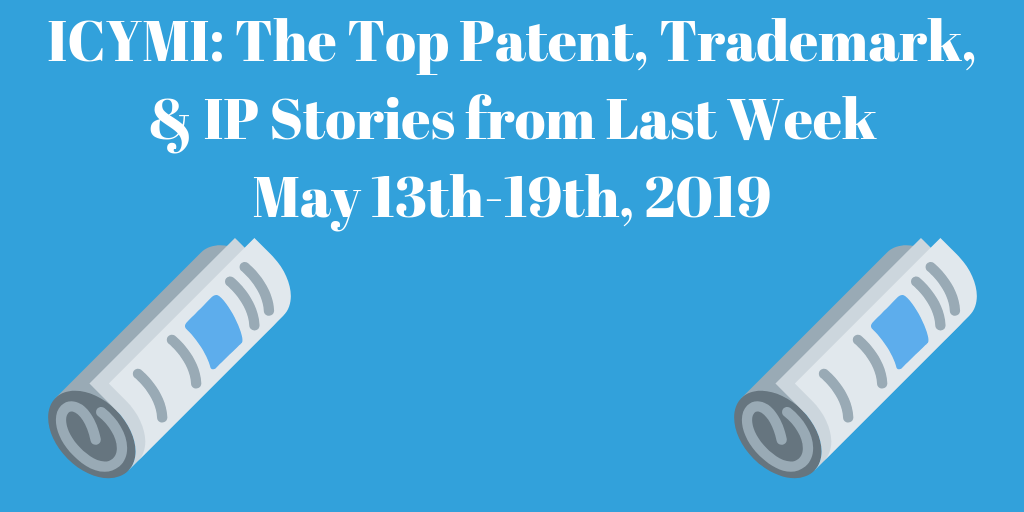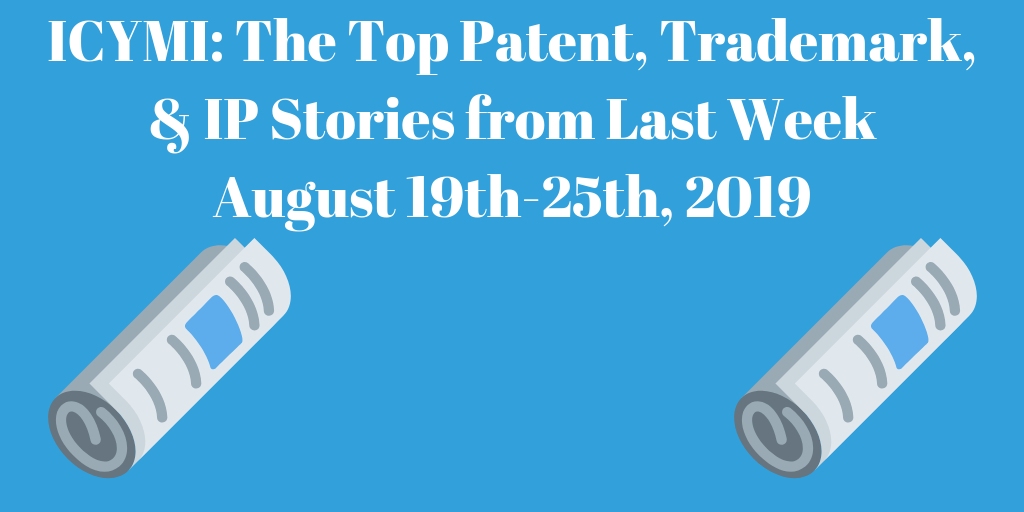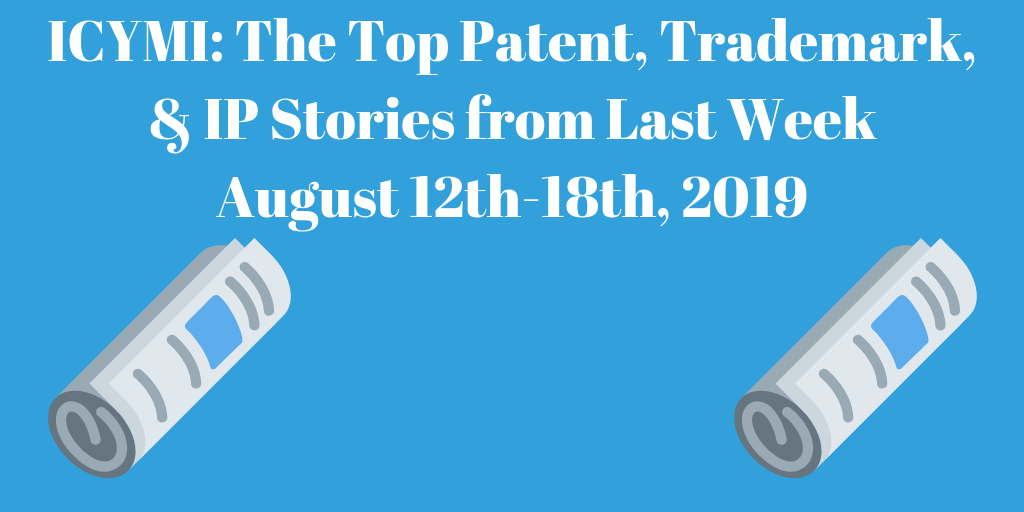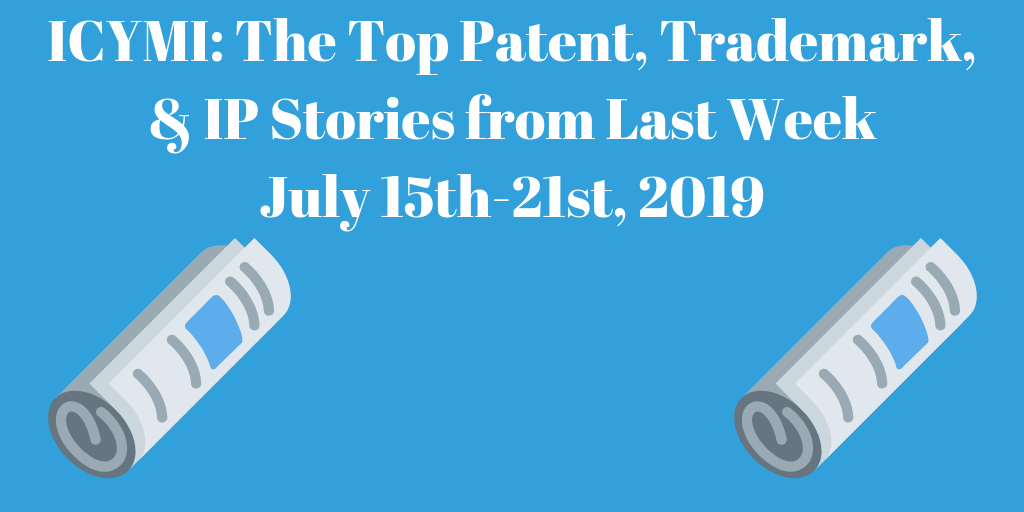Top Patent, Trademark, and IP Stories from Last Week (5/13-5/19/19)
Every week, we will be highlighting the top patent, copyright, trademark, intellectual property, etc. stories of the previous week in our “In Case You Missed It” segment. The list itself is in no particular order and includes a wide range of stories from the patent world that are informative, noteworthy, or just plain bizarre. The stories included encompass everything from Supreme Court cases to insights into growing industries. Please feel free to comment your thoughts on the stories or share an important one we missed!
“CBD Wins With USPTO’s New Examination Guide for Cannabis Marks, but Lawful Use Requirements Remain Intact”
Earlier this month, the USPTO released a new examination guide dubbed “Examination of Marks for Cannabis and Cannabis-Related Goods and Services after Enactment of the 2018 Farm Bill.” The guide states that marijuana products unable to be legally sold between states, those with THC content >0.3%, cannot be registered for trademarks. That said, because the 2018 Farm Bill now allows for interstate commerce of products such as CBD oil (THC <0.3%), hemp, and other cannabis derivatives, the USPTO has ruled these products can be trademarked.

The USPTO maintains that products in violation of federal law and/or the Controlled Substances Act will be refused trademark protection. Applicants not in violation of federal law must specify the THC content of their products in their application. For applications submitted before December 20th, 2018 (Farm Bill signed into law by President Trump), these will be refused due to “the unlawful use or lack of bona fide intent to use in lawful commerce under the CSA.” The USPTO contends these applications did not have a “valid basis” for being submitted when they were given they were in violation of federal law at the time.
As the USPTO warms up to cannabis protections, the lawful use requirement remains an obstacle for a large chunk of the industry. To read more about this story, click here (via IPWatchdog, May 14th, 2019).
Summary: Statement of Director Iancu before the United States House Subcommittee on Courts, Intellectual Property, and the Internet Committee on the Judiciary
On May 9th, USPTO Director Andrei Iancu testified before the United States House Subcommittee on Courts, Intellectual Property, and the Internet. In his statement, Iancu asserted the goals of the USPTO are to instill confidence in a “predictable and well-functioning IP system.” Iancu also addressed the need to reduce the application backlog and pendency as well as improve patent quality. As for the public uncertainty about what is patentable given the Bilski, Mayo, Myriad, and Alice decisions, Iancu acknowledged this and plans to reduce it.
Below are some of the USPTO’s initiatives Iancu laid out:
- Clear patent examination guidance; reduce public uncertainty over subject matter eligibility
- By the end of FY2019, reduce the average time to first action pendency to <15 months. Current average is 15.9 months
- By end of FY2019, maintain total average pendency time of <24 months. Current average is 23.7 months
- Supply patent examiners with clearer guidelines for more effective prior art searches, clearer written prosecution records, and more efficient patent examination. Goal is to find prior art as quickly as possible and reduce pendency time
- Improve examiner searches through the availability of more search training opportunities, increase AI integration and other technology, and implement pilot search programs
- Provide education for stakeholders on how and why a patent examiner makes their decisions to better understand the process and enforcement of guidelines
- Encourage commercial, industrial, and academic institutions to host patent examiners in order to see technologies firsthand
- Gather applicant feedback
- Ensure patent lawyers, judges, paralegals, etc. are knowledgeable of latest policy developments
- Crack down on fraudulent applications through the use of random audits to ensure proper use of mark, software to detect fake/doctored specimens, require the use of U.S.-licensed attorneys for foreign applicants
- Promote global patent granting collaboration
- Educate applicants on how to best protect and enforce their IP in China
- Modernize USPTO; incorporate state-of-the art technology
To read this report in full, click here (via USPTO, May 9th, 2019)
“Patent Trend Study Part Nine: Blockchain”
Thomas Franklin, author of a new report on industry patent trends, goes into detail about an emerging industry we have covered extensively in recent months, blockchain. For those unaware, “blockchain” is an unalterable “chain” of records such as times, dates, etc. called “blocks” that can be used to keep a record of transactions and verify them with timestamps. It is “decentralized” meaning no single authority controls it or has the ability to modify it. It can be used in voting, banking, healthcare, and endless other applications.
Currently, cryptocurrency remains the most applied area for blockchain patents, followed by logistics and ecommerce, fintech, energy distributions, healthcare, and others. Franklin’s report also found an influx of foreign blockchain applications to the USPTO with the share of patents granted to countries outside the U.S. growing each of the past 5 years.
Given growing mainstream attention to the technology and its real world applicability, keep an eye on whether blockchain filings continue to surge. Side note: It was just announced top banks will invest $50 million into blockchain technology. To read more about this story, click here (via IPWatchdog, May 13th, 2019)
“Grumpy Cat’ Leaves Behind Business Empire and Some Copycats”
The world grieved the recent passing of beloved “Grumpy Cat” last week. The feline was the center of countless memes on the web dating back to 2012. Grumpy Cat’s fame extended well beyond memes however. She was the face of Cheerios and Friskies campaigns, had her own movie and best-selling book, and was even on the cover of New York Magazine. In 2014, she reportedly earned $100 million.

With such fame and earning potential, it may come as no surprise Grumpy Cat had plenty of trademarks. Numerous “Grumpy Cat” trademarks can be found on the USPTO site. These marks allow for use on pet food, paper products (stickers, cards, gift wrap, etc.), coffee and tea, shirts, mugs, magnets, calendars, games, apps, toys, action figures, and more. In summary, this cat had an empire and it is one she protected. In 2018, the cat won a $700,000 copyright lawsuit. To read more about this story, click here (via Cheddar, May 17th, 2019).




